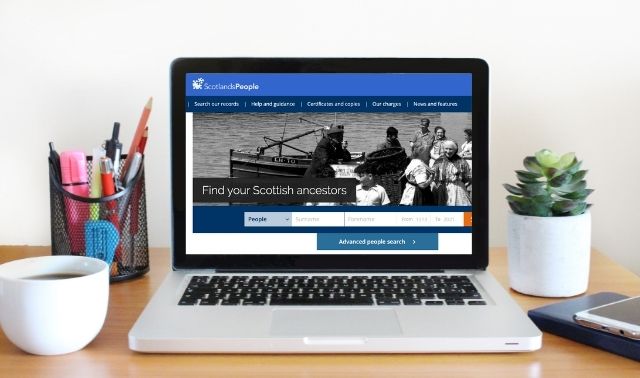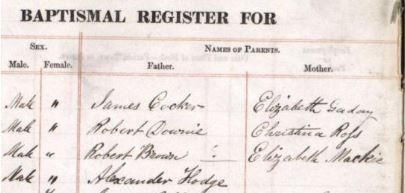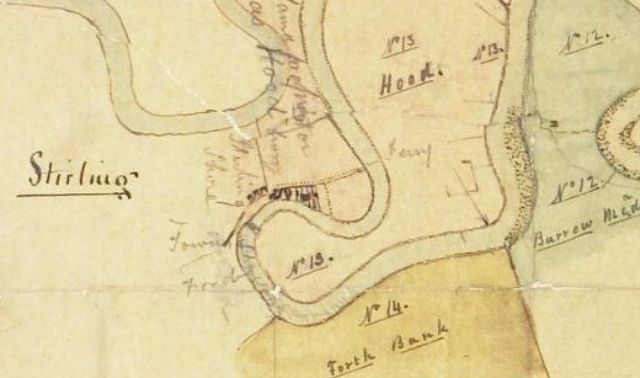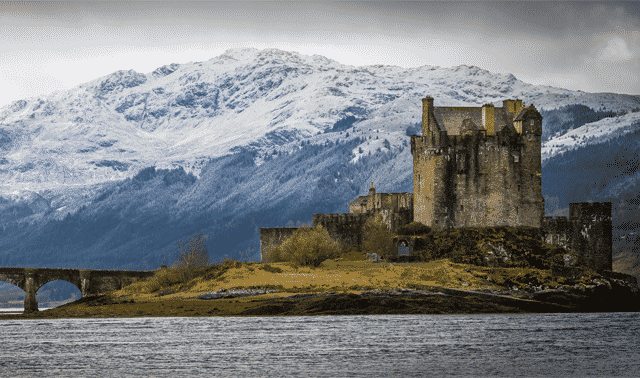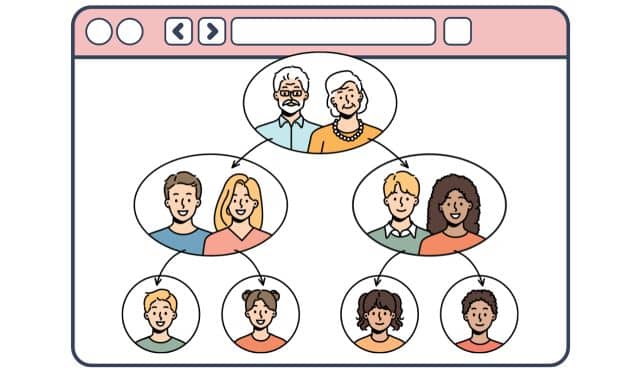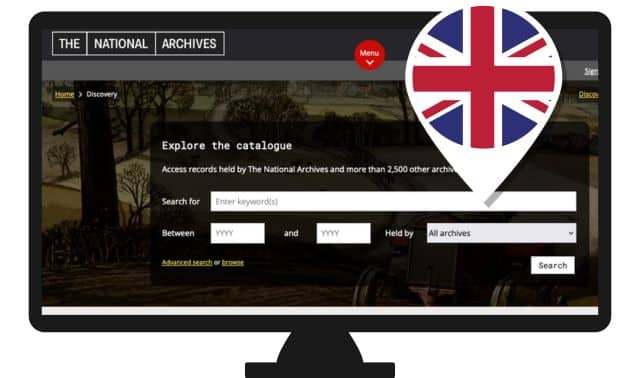Sign up for the Family Tree Newsletter Plus, you’ll receive our 10 Essential Genealogy Research Forms PDF as a special thank you!
Get Your Free Genealogy Forms
"*" indicates required fields
Imagine having all the most important genealogical records for an entire country online. Not just record images, but name indexes, too. Official birth, marriage and death records back to 1855. Church records back to 1553. Wills back to 1513. Plus census, tax and court records, not to mention a huge collection of historical maps. That describes the amazing record collections on ScotlandsPeople—truly a genealogist’s dream come true. If you have Scottish ancestry, there’s a good chance you can make considerable progress researching your family history by relying entirely on the records on this website. This guide will get you started.
Records Indexed by Personal Name
ScotlandsPeople gives you access to a wide range of records kept by the Scottish government, churches and courts. Records in six categories are indexed by name: statutory (civil) registers, church registers, census returns, valuation rolls, legal records and poor relief and migration records. To access them, click on “Search our records” and then on “Advanced people search.” After registering and logging in, you can search all of these collections for free, but most of them require a fee to view and save record images.
Statutory Registers
Statutory registers—official records of births, marriages and deaths—have been kept by the government since January 1, 1855. In the late 20th century, the government also began keeping registers of divorces, dissolutions and civil partnerships. You can search statutory register indexes covering the earliest records up to the present day.
Many records can be viewed online, including birth records over 100 years old, marriage records over 75 years old and death records over 50 years old. Click on Certificates and Copies to order more recent records. FamilySearch has indexes to many birth and marriage records, but only ScotlandsPeople has an index to the death records.
The registers cover some events pertaining to Scots abroad:
- The birth register includes some births of children to Scottish parents in foreign countries, births on British-registered merchant vessels at sea where one of the parents was usually a resident of Scotland, and births of Scottish persons at military stations abroad.
- The marriage register includes some marriages of Scots in foreign countries and at British military stations abroad.
- The death register covers some Scots who died in foreign countries, Scottish residents who died on British-registered merchant vessels at sea, Scottish deaths at military stations abroad and the deaths of Scottish soldiers in the South African War from 1899 to 1902.
The records are typically very informative:
- Birth records contain the child’s name, date and place of birth, the father’s name and rank or profession, the mother’s maiden name and even the date and place of the parents’ marriage.
- Marriage records contain the date and place of marriage; the couple’s names, ages, marital status, rank or occupation and place of residence; their fathers’ names and rank or profession; and their mother’s name.
- Death records contain the person’s name; rank, profession or occupation; marital status; the date, place and cause of death; age at death; the father’s name and rank or profession and the mother’s maiden name; the cause of death; and the place of burial.
Throughout 1855 during the first year of statutory civil registration, the birth, marriage and death records are two pages long and include additional information:
- Birth records name other children born to the couple and note if the children were living or deceased. They also give the parents’ ages, birthplaces and places of residence.
- Marriage records give the couple’s places of birth, the number of each spouse’s former marriages and the number of children by those marriages.
- Death records include the deceased’s place of birth and the names and ages of his or her children.
Those records are especially valuable to researchers. So, if you have a Scottish ancestor who was born, married or died in 1855, be sure to get a copy of the record! Beginning the next year, 1856, the format for birth, marriage and death records was shortened to a single page with less information.
Church Registers
ScotlandsPeople has records of the Church of Scotland (Presbyterian), the Roman Catholic Church and other churches.
Records of the Church of Scotland before the introduction of civil registration in 1855 are known as the Old Parish Registers or Old Parochial Registers (OPRs). Individual parishes kept records of births and baptisms, banns and marriages and deaths and burials. Starting in 1552, parishes were required to record baptisms and marriages. There was no requirement to record deaths and burials, so many parishes did not do so. The earliest surviving register dates from 1553, but many don’t begin until the early 19th century. Some registers have been lost or are in poor condition. Registering an event was costly, so many people didn’t bother with it.
The earliest surviving Catholic church registers date from 1703, but most don’t begin until the 1790s or later.
Records of baptism usually contain the names of the child and parents and the date of baptism. Sometimes they also include the date of birth, the mother’s maiden name, the parents’ place of residence, the father’s occupation and the names of witnesses.
The proclamation of banns—the notice of contract of marriage—was supposed to be read out in church on three successive Sundays before the marriage took place. Most records of banns and marriages contain very little detail. You might find only the names of the bride and groom and the fee paid to prove the seriousness of their intentions. If you’re lucky, the record might also include the date of the proclamation of intended marriage, the date of the marriage, the couple’s parish of residence, the groom’s occupation and the name of the bride’s father. Those clues can help you find the bride’s and groom’s records of birth and baptism.
The few death and burial records that exist in the parish registers contain sparse information. You might find only a name and the date of death or burial, making it hard to determine if it’s the right person. Sometimes the record adds the age at death, the cause of death, the name of the spouse or father and the place of residence. A married woman might be referred to by her maiden name, as someone’s wife (“John Ferguson’s wife”) or as a widow (“Widow Ewing”).
When searching the church registers, you might get the best results by starting your search broadly, with a given name, a surname and a county. Specify a parish if you get too many matches.
Census Returns
An official census of Scotland’s population has been taken every ten years since 1801, except in 1941 during World War II. Little information on individuals survives from the censuses from 1801 through 1831.
ScotlandsPeople has the censuses from 1841 to 1911 and will release the 1921 census in the latter half of 2022. Indexes to all the census years are linked to digital images. A second index to the 1881 census was coordinated by the Church of Jesus Christ of Latter-Day Saints (LDS) and links to a transcription. The LDS index lets you search on occupation, address, census place and birthplace.
Census records provide many useful details. Starting in 1851, the Scottish census shows each person’s relationship to the head of household and the county and parish or country of birth.
Valuation Rolls
Valuation rolls list properties in each Scottish county and burgh between 1855 and 1996. They include the names of the proprietor (owner), tenant and occupier, plus the rateable value based on the property’s annual rental value. These records can help you locate people between census years and reveal whether they owned or rented their home or other property.
ScotlandsPeople has valuation rolls for every ten years from 1855 to 1935, plus 1920 and 1940. Information in valuation rolls varies. Later ones are more detailed and usually include the property’s address; the type of property, such as a house or shop; the proprietor’s name; the name of the occupier or tenant; occupation; and the property’s yearly rent or rateable value.
Unlike census returns, valuation rolls do not list all the occupants of each house. They show just the owner and the resident head of household, each of whom was responsible for half the local tax.
Legal Records
This category covers records created by Scottish courts of law. Four important collections of legal records on ScotlandsPeople are coats of arms, military service appeals tribunal records, soldiers’ and airmen’s wills, and wills and testaments.
- Coats of arms. Originally used for military purposes, coats of arms consisted of an actual coat bearing a distinctive design and worn over a suit of armor. ScotlandsPeople has records of all legal coats of arms in Scotland from 1672 to 1920. They can include a lot of genealogical information. By the mid-nineteenth century, they often show the individual’s line of descent from his grandfather or an earlier ancestor.
- Military service appeals tribunal records. Starting in 1916, men seeking exemption from military service could apply to local tribunals. A man or his employer could claim an exemption on the grounds that it was in the national interest to continue his current work. Other grounds for exemption included ill health and conscientious objection. If the local tribunal rejected the exemption, a man could take his case to an appeal tribunal and ultimately to a central tribunal in London. Appeals cover the years from 1916 to 1918 and only a few tribunal papers survive.
- Soldiers’ and airmen’s wills. This collection includes the last wishes of 26,000 ordinary Scottish soldiers. Most of them were killed in action, died of wounds or went missing during World War I. Most of the wills were written in their pay books by Scottish soldiers below the rank of officer. Also included here are some wills of Scottish soldiers who served during World War II, the South African War, the Korean War, and other conflicts between 1857 and 1965. These records often reveal details on the soldier’s military service, the name of the person who is the beneficiary of the will and the soldier’s date of death.
- Wills and testaments. This collection includes two types of documents relating to the settlement of a deceased person’s property. A will specifies how a person wishes to dispose of his or her possessions after his or her death. A testament, drawn up after someone has died, enables the court to confirm an executor responsible for winding up the deceased’s affairs. Almost every will and testament in this index contains an inventory of the deceased’s property. It might tally household furnishings, clothes, books, papers, tools, machinery, bank accounts and investments. And it could mention family members. The wills and testaments index on ScotlandsPeople has more than 611,000 entries to wills and testaments dating from 1513 to 1925. The index does not cover the names of executors or heirs.
Poor Relief and Migration Records
Click on Search Our Records > Advanced People Search > Poor Relief and Migration Records > Highland and Island Emigration to search records of the Highland and Island Emigration Society, set up to relieve destitution in the Scottish Highlands. The passenger lists cover nearly 5,000 emigrants from western Scotland to Australia between 1852 and 1857. It was thought that Highlanders’ experience as shepherds and cattle drovers would suit them well in the Australian colonies. The records sometimes include notes on the passengers’ health and appearance.
Other Records
Kirk Sessions
In the eighteenth century, Scotland had about 940 parishes, each with its own church. Local church courts, known as kirk sessions, were held by the Church of Scotland beginning in 1560. Each parish had a kirk session composed of the minister and ruling elders. The kirk session’s responsibilities included maintaining good order in the congregation, administering discipline and providing relief for the poor. In addition to recording the proceedings of disciplinary cases on a variety of moral and social offences, kirk session minutes may include records of baptisms, marriages and burials, plus notices of people who joined or left the parish. The names of recipients of poor relief are recorded either in the minutes or in separate poor relief accounts.
The kirk sessions records on ScotlandsPeople are not indexed by name, but you can browse them. Let’s say you’re looking for records of the parish of Kilmadock in the county of Perth. Click on Search Our Records > Search Virtual Volumes > Search Places. Enter Kilmadock in the Place Name box and click on Search. There’s only one match on that name. Click on Kilmadock and you’ll get links to two kirk session records: Kilmadock kirk session is the main one for that parish. The link to the Norriston kirk session notes that part of Kilmadock parish was split off and added to Norriston parish in 1877. Click on the link to Kilmadock kirk session and you can browse the minutes from 1652 to 1872. Using the links, you can jump to the records for a specific year. The names of some of the key parties to cases are written in the left margin. For example, the names Robertson and McDonald appear in the margin on page 290 of the minutes from February 28, 1789. They say that Margaret Robertson sought “repentance for the sin of fornication with James McAul alias McDonald.” She was “rebuked and absolved” on November 11.
Image Library
Click on Search Our Records and then on Image Library to find historical photographs, illustrations and manuscripts dating back to medieval times. You can limit your search to a category, such as Armed Forces, Scots Abroad and Ships, and to a range of years.
Maps and Plans
Click on Search Our Records and then on Maps and Plans to search a collection of over 170,000 maps, plans and architectural and engineering drawings. They come from many sources, including government records, court papers, church records and private family collections. The “Search for” box lets you search for words in titles and descriptions. In addition to place names, it’s worth searching for other terms, such as personal names, the names of rivers and other geographic features. You can also search by county or county and parish and limit your search by a range of years.
When searching for farm names and hamlets, I’ve had better luck using the National Library of Scotland’s map images, especially the Ordnance Survey maps.
Fees
Once registered, you can search the indexes for free. You only pay to view and save record images and to order certificates. There’s also a fee to save a high-resolution copy from the Image Library. You can view some records for free, including maps and plans, kirk sessions records, records of the Highland and Island Emigration Society and the transcribed version of the 1881 (LDS) census.
Rick Crume has traced his ancestors in the Scottish counties of Perth and Stirling back to the 18th century.
Related Reads
ADVERTISEMENT

